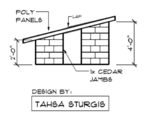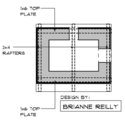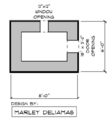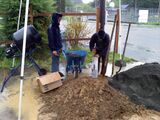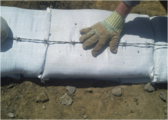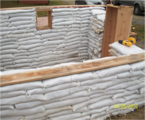

This page discusses Bags of Shelter, an earthbag shelter designed for World Shelters to use as transitional shelter for people in Haiti affected by the January 2010 Earthquake. World Shelters is a non-profit organization dedicated to producing housing for disaster relief and general humanitarian needs. A four person design team, Humangineers, designed Bags of Shelter as part of Lonny Grafman's Introduction to Design class at Cal Poly Humboldt.
Background[edit | edit source]
This project was done for our 12-week assignment for Introduction to Design for the Spring 2010 semester. Our client, World Shelters, asked Humangineers to use dirt as a resource in order to provide transitional housing for the people of Haiti. Seven criteria were established by World Shelters and they include: Level of Safety, Use of Local Labor, Durability and Repairability, Ratio of Dirt of the Structure, Cost, Ease of Mass Production and Ecological Impacts.
Problem Statement and Criteria[edit | edit source]
Problem Analysis Specifications[edit | edit source]
World Shelters asked that Humangineers use dirt as a resource for designing a transitional shelter in Haiti. Haiti has a lot of dirt available, but lacks a way to use it in some meaningful way.
Specifications[edit | edit source]
The specifications of this project are factors that must be implemented in the design process. The following three specifications will be considered during the design process: Dirt is to be used as the primary building resource; design must be able to provide long-term housing; assembly labor is to be done manually utilizing the labor force in Haiti.
Criteria[edit | edit source]
Our team met with our client, Kurt Therkelsen, from the organization World Shelters (W.S.) on February 11, 2010 to introduce our semester design project. Kurt explained the requirements for our group's project on February 25th. He discussed how the project will, ideally, be used as temporary long-term housing in the disaster relief effort in Haiti. A main concern of our client was the use of local labor and resources. Further requirements for the design project discussed by our group are in table 1. In addition each criterion was weighted on a scale from 1-10 based on level of importance, with 10 being the highest and 1 being the lowest.
| Criteria | Weight |
|---|---|
| Level of Safety | 10 |
| Durability, Repairability | 9 |
| Use of Local Labor | 9 |
| Cost | 8 |
| Ratio of Dirt | 8 |
| Ease of Mass Production | 7 |
| Ecological Impacts | 4 |
Considerations[edit | edit source]
Soil samples from Haiti will be unavailable during this project. As a result, an assumption that Haiti has an abundance of clay will be made while making our designs. Research indicates that Haiti's soil contains red clay (Haiti, 2010).
Description of Final Project[edit | edit source]
Bags of Shelter is a one third-scale model shelter made from earthbags. Before construction, Bags of Shelter requires a trench foundation to provide long-term support. The group Rubblution constructed a rubble trench foundation which was 9 inches deep and 9 inches wide. The dimensions of Bags of Shelter are 6' by 8' and can be seen in Figure 5. Detailed CAD drawings of our design can be seen below.
The Walls[edit | edit source]
The walls of Bags of Shelter are constructed from polypropylene bags which are filled with an earthen mixture and stacked on top of one another. The earthen mixture consists of 75% sand and 25% clay, (figure 6). Once filled, the bags are compacted to be as flat as possible and stacked on top of one another to form the walls of the shelter. Between each layer of bags a strip of four-point, barbed wire is run along the surface of the bags which provide support (Figures 7 and 8). Door and window frames must be inserted as the walls are constructed to prevent the bags from slipping in.
Bags of Shelter requires a sloping roof for weather proofing so wall heights vary. Half-scale dimensions of wall heights can be seen in Figure 3. One wall is 2 feet high, the opposite side 4 feet high, and the remaining 2 walls are sloping.
The Roof[edit | edit source]

The roof of Bags of Shelter is made of polypropylene sheeting. The model size shelter requires 2 sheets cut to scale. These sheets are attached by screws or nails to rafters that are attached to the framework of the roof. The framework is made of 1"x6" Boards that are layed across the top most layers of the bags and secured on with wire. Figure 9 shows two holes which are drilled through the 1"x6" boards every four feet. The wire is wrapped through these holes and secured down underneath the top three layers of bags. The CAD drawing depicted above in Figure 3 shows a side view of the roof, which has a two foot slope and a one foot overhang in order to protect the structure from water damage.
The Door and Windows[edit | edit source]
Bags of Shelter has two windows and one door. One window can be seen in figure 2, and is one foot by one foot. Figure 3 shows the doorway which is combined in the drawing with the second window. The design is such that there is no earthbag load on the top of the window and door frames, therefore less lumber is necessary and the total materials costs are reduced.
The Protective Coating[edit | edit source]
To prevent the polypropylene bags from degrading, a protective coating is required for this structure. This protective coating can be made from many different possibilities including, plaster, papercrete, lime, etc. In addition to the coating it is recommended that two coats of lime wash be painted on as a final coat. In this project the protective coating was not implemented due to the short lifespan of the model structure.
Total Costs[edit | edit source]
Hours[edit | edit source]
The design costs indicate the quantity of hours that Humangineers as a team has put into this design project. Humangineers has spent 426.67 hours on this design project. The design hours spent in phase 5 total 310.47 hours. Figure 10 represents the distribution of hours that went into this project.
Materials[edit | edit source]
Figure 11 indicates the costs of materials used in the construction of Bags of Shelter. The total amount spent to construct the project was $222.47. Because many items were donated, a column for projected costs is included in Table 2. The total projected costs for Bags of Shelter is $272.81. Also included in the list of materials is implementation costs, these are estimates of what a full scale structure would cost to be erected in Haiti.

| Table 2. Itemized Cost of Materials | ||||
|---|---|---|---|---|
| Materials | Use | Quantity | Project Cost ($) | Projected Project Cost ($) |
| Polypropylene Bags (15 x27 in.) | Building Blocks | 225 | 112.87 | 112.87 |
| Polypropylene Bags (9 x18 in.) | Building Blocks | 20 | Donation | 10.80 |
| 18 Gauge Wire | Roof Reinforcement | 36 ft. | Donation | 18.99 |
| Sand | Fill Material | 3.87 tons | 86.6 | 45.00 |
| Clay | Fill Material | .97 tons | Donation | 4.75 |
| Polypropylene Sheet | Roofing | 8.5 x 7 | N/A | N/A |
| Thread | Sewing Poly Bags | 4 rolls | 5.00 | 5.00 |
| 20 Gauge Wire Strips | Sewing Poly Bags | 4 packs | 8.00 | 8.00 |
| 4 Point Barbed Wire | Intermediate Support | 358 ft | Donation | 21.00 |
| Lumber (1x12) | Door, Window Frame | 13 ft | Donation | 4.80 |
| Lumber (1x6) | Roof Frame | 28 ft | 10 | 10.00 |
| Lumber (2x4) | Roof Rafters | 21 ft | Donation | 6.75 |
| Screws | Door, Window Frame | 16 | Donation | 1.60 |
| Total | 222.47 | 231.21 |
Results[edit | edit source]
Figures 12 through 15 show Humangineers final stages of construction. Humangineeers successfully built a model size structure of an earthbag house. The use of the earthbags combined with the barbed wire provides a sturdy as well as stable structure.
Discussion and Next Steps[edit | edit source]
Humangineers recommends Bags of Shelter because it is a suitable design for World Shelters and meets the client criteria. Bags of Shelter uses dirt as a primary building resource. The design also provides a way for Haitians to stimulate their local economy by making barbed wire and also by building the entire structure itself. Overall, Bags of Shelter is a functional design for transitional housing in Haiti. Humangineers recommends the use of lime plaster as an exterior coating for the structure. Humangineers also recommends proper testing to ensure safety of inhabitants using this design for housing. Testing needs to include both hurricane and earthquake resistance. If this design were to be implemented, Humangineers suggests eventually replacing the polypropylene roofing with something that will provide long-term needs, such as metal roofing.
References[edit | edit source]
"Haiti". History.com. 5 May 2010. http://web.archive.org/web/20120616200034/http://www.history.com/topics/haiti
World Shelters, 2009. "Involvement." < http://worldshelters.org/home> (Feb. 27, 2009)

